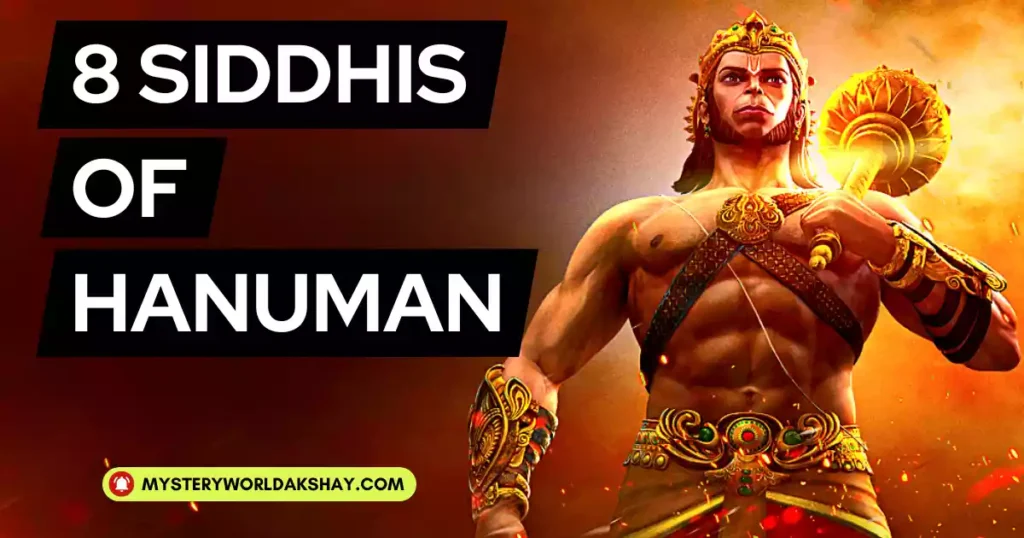Introduction
Hanuman, the Hindu monkey god, is a prominent figure in the Hindu religion and mythology. He is revered as the symbol of devotion, strength, and loyalty. According to Hindu mythology, Hanuman possessed eight supernatural powers, known as siddhis, which he used to help Lord Rama during his battles. In this article, we will look at 8 siddhis of Hanuman and what they mean in Hindu legends.
Hanuman’s Significance in Hindu Mythology
Before we talk about the 8 siddhis of Hanuman, let’s first know who Lord Hanuman is and why he is so vital in Hindu stories. Hanuman is a monkey god.
Many Hindus worship him as the symbol of strength, devotion, and loyalty. Hanuman is famous for what he did in the Ramayana. He helped Lord Rama save his wife, Sita, from a demon king named Ravana.
Hanuman’s unwavering devotion to Lord Rama and unparalleled strength and loyalty make him a respected figure in Hindu mythology.

What are Siddhis?
Siddhis are supernatural powers or abilities believed to be attained through spiritual practices such as meditation, yoga, and austerities. These special powers are connected to the gods of Hinduism, and achieving them is seen as a sign of spiritual progress.
The 8 Siddhis of Hanuman
According to Hindu mythology, Hanuman possessed eight siddhis, which he used to help Lord Rama during his battles. The 8 siddhis of Hanuman are mentioned below: –
1. Anima Siddhi


Anima Siddhi is the ability to become smaller than the smallest particle. This power enabled Hanuman to enter the city of Lanka undetected in search of Sita.
2. Mahima Siddhi


Mahima Siddhi is the ability to become larger than the largest object. Hanuman used this power to grow his size while carrying Lord Rama and Lakshmana on his back during the battle with Ravana.
3. Garima Siddhi


Garima Siddhi is the ability to become incredibly heavy. During their battle, Hanuman used this power to weigh down the demon king Ravana.
4. Laghima Siddhi


Laghima Siddhi is the ability to become incredibly light. Hanuman used this power to leap across the ocean to reach the island of Lanka, where Sita was held captive.
5. Prapti Siddhi


Prapti Siddhi is the ability to obtain anything one desires. Hanuman used this power to find the Sanjivani herb to save Lakshmana’s life during the battle with Ravana.
6. Prakamya Siddhi


Prakamya Siddhi is the ability to accomplish anything one desires. Hanuman used this power to defeat the demon king Ravana during the battle and to bring back the news of Sita’s location to Lord Rama.
7. Ishita Siddhi


Ishita Siddhi is the ability to control the five elements of nature – earth, water, fire, air, and space. Hanuman used this power to extinguish the fire on his tail after he set the city of Lanka on fire.
8. Vashita Siddhi


Vashita Siddhi is the ability to control one’s and others’ minds. Hanuman used this power to inspire the monkey army to fight alongside Lord Rama during the battle with Ravana.
The Significance of the 8 Siddhis of Hanuman
The 8 siddhis of Hanuman are fascinating and hold significant meaning in Hindu mythology. These powers demonstrate Hanuman’s devotion, strength, and ability to overcome obstacles. The siddhis are a sign of the main aim of spiritual practices in Hinduism: to achieve freedom from being born and dying repeatedly.
The siddhis also inspire spiritual seekers to strive for spiritual advancement and cultivate qualities such as devotion, strength, and perseverance. They also make us remember how strong belief can be and how serving something greater is significant.
How can one attain the 8 siddhis of Hanuman?
People think they can get these abilities by doing spiritual activities like meditating, doing yoga, and being disciplined. But it’s better to focus on more than just getting these abilities. Instead, individuals should aim to enhance their spiritual well-being because they desire to comprehend their true identity and escape the cycle of birth and death.
Therefore, it is essential to approach spiritual practice with a pure heart and intention and not become attached to attaining siddhis. Hanuman’s devotion to Lord Rama is a model for spiritual seekers to cultivate devotion and selflessness. By serving a higher cause and surrendering to a higher power, one can develop the qualities necessary for spiritual advancement.
The Importance of Worshipping Hanuman
Hanuman is widely worshipped by Hindus, especially those seeking strength, courage, and devotion. Hanuman is believed to represent devotion and is a role model for people to learn how to be devoted and unselfish in their own lives.
Lord Hanuman’s worship is also believed to provide protection against evil forces and to overcome obstacles in one’s life. Many Hindus also believe that worshipping Hanuman can help relieve the harmful effects of astrological influences.
Conclusion on 8 Siddhis of Hanuman
In conclusion, the 8 siddhis of Hanuman are a fascinating aspect of Hindu mythology that demonstrate Hanuman’s strength, devotion, and unwavering loyalty to Lord Rama. These powers also inspire spiritual seekers to strive for spiritual advancement and cultivate qualities such as devotion, strength, and perseverance.
Hanuman worship is widely practised by Hindus and is believed to provide protection against evil forces and to overcome obstacles in one’s life. By worshipping Hanuman, devotees seek to cultivate the qualities of devotion, strength, and selflessness in their lives and to serve a higher cause.
FAQs
1. What is the significance of Hanuman’s tail?
Hanuman’s tail symbolizes his strength, as it is said to have the power of the sun and the ability to grow or shrink at will.
2. What is the significance of Hanuman’s devotion to Lord Rama?
Hanuman‘s devotion to Lord Rama inspires many devotees to cultivate loyalty and selflessness in their lives.
3. What are the benefits of worshipping Hanuman?
Worshipping Hanuman is believed to provide protection against evil forces and to overcome obstacles in one’s life.
4. What is the importance of the 8 siddhis of Hanuman?
The 8 siddhis of Hanuman demonstrate his strength, devotion, and his ability to overcome any obstacle. They can also motivate people searching for spiritual growth to work hard to improve themselves and develop qualities like dedication, resilience, and determination.
5. Can anyone attain the 8 siddhis of Hanuman?
The 8 siddhis are connected to Hindu gods and goddesses and are thought to be achieved by doing spiritual things like meditating, doing yoga, and being disciplined.
6. Which are the 8 siddhis of Hanuman?
The 8 siddhis of Hanuman are Anima, Mahima, Garima, Laghima, Prapti, Prakamya, Ishita, and Vashita.
